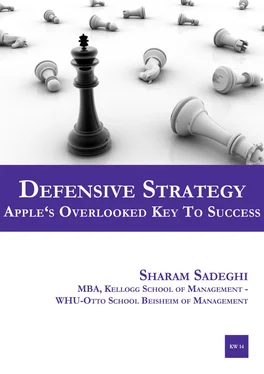Defensive Strategy – Apple’s Overlooked Key To Success
Sharam Sadeghi
Published by: epubli GmbH, Berlin, www.epubli.de
Copyright: © 2012 Sharam Sadeghi, All rights reserved.
ISBN 978-3-8442-3143-4
Copyright: © 2012 Sharam Sadeghi, All rights reserved.
Cover picture copyright: © O2creationz/shutterstock.com
No part of this publication may be reproduced, stored in a retrieval system or transmitted in any form or by any means, electronic, mechanical, photocopying, recording or otherwise, without the prior permission of the copy right owner.
Designations used by companies to distinguish their products are often claimed as trademarks. All brand names and product names used in this book are trade names, service marks, trademarks or registered trademarks of their respective owners.
Sharam Sadeghi, the author of this eBook, is a sales and marketing professional with proven success in driving marketing strategies and execution at Fortune Global 500 companies: His career started at The Coca-Cola Company, before he moved to Sony, LG Electronics and Vodafone in Germany. His marketing expertise spans the full marketing mix spectrum with key responsibilities in product marketing, brand management and direct marketing.
Defensive Strategy – Apple’s Overlooked Key to Success is the topic of his Master Thesis to complete the two-year’s Executive MBA program in August 2012, held at Northwestern University’s Kellogg School of Management in partnership with WHU-Otto Beisheim School of Management.
Visit my blog: MarketingStrategyThinkTank.wordpress.com
Tim Calkins, the supervisor of this publication, is clinical professor of marketing at Northwestern University’s Kellogg School of Management. Tim teaches marketing strategy, biomedical marketing and strategic marketing decisions in Kellogg’s full-time, part-time and executive MBA programs. He is co-academic director of Kellogg’s branding program.
He is the author of Defending Your Brand: How Smart Companies Use Defensive Strategy to Deal with Competitive Attacks (Palgrave Macmillan, 2012) and Breakthrough Marketing Plans (Palgrave Macmillan, 2008). He is co-editor of Kellogg on Branding (John Wiley & Sons, 2005). Tim has published more than a dozen Kellogg case studies including Crestor, MedImmune: FluMist Introduction and Genzyme: the Synvisc-One Investment Decision.
“Stay hungry! Stay foolish!”
Table of Contents
1. Defensive Strategy – Introduction...
2. Defensive Strategy – The Apple Way of (i)Defense..
2.1 A Company in Transformation: From Apple Computer, Inc. to Apple Inc.
2.2 Let The Music Play – Apple’s “Digital Hub Strategy”.
2.3 iDefend – How Apple Succeeds to Defend its Position Successfully.
2.3.1 Create a vertical product line that meets different customer needs!
2.3.2 Play a price orchestra along the product line to lock out competition!
2.3.3 Welcome to Troy: Create an ecosystem that works seamlessly!
2.3.4 Know what is best for your customer, make them want it and keep them!
2.3.5 Eat up resources your competitor might need and weaken their ability to maneuver!
2.3.6 Revolutionize your Supply Chain Management to increase efficiency & flexibility!
2.3.7 Create direct access to your customers via own retail stores!
2.3.8 Build up a patent wall & use your intellectual property as defensive assets!
2.3.9 Strengthen your financials to strengthen your fortress!
2.3.10 Create a fluid, agile organization and be mystical about it!
2.4 (i)Defend – The Apple Conclusion.
3. Defensive Strategy – The Theories Behind the Concept..
3.1 What Is Defensive Strategy & Why Does It Matter?.
3.2 Why Companies Fail to Defend?.
3.3 Which Defensive Strategy Should a Company Consider?.
3.4 How to Defend Effectively?.
4. Defensive Strategy – Summary..
5. Acknowledgements.
6. References.
Table of Figures
Figure 1:Apple’s Revenue Split Traditional Sales vs. post-PC Device Sales (2002-2011)
Figure 2:Worldwide Revenue Development of the Music Industry (2001-2011)
Figure 3:Worldwide Shipment of Portable Media Players (2005-2012)
Figure 4:Apple’s Advertising-to-Net Sales Ratio (2002-2011)
Figure 5:Apple’s Unit Sales by Category (2002-2011)
Figure 6:DRAMeXchange: Supply/Demand Sufficiency Ratio.
Figure 7:Quarterly Profit Margin Development Apple vs. Foxconn.
Figure 8:Apple Retail’s Net Sales Development (2003-2011)
Figure 9:Choosing the Right Defensive Strategy (by John H. Roberts)
Figure 10:Value and Vulnerability (by John H. Roberts)
1. Defensive Strategy – Introduction
In times, in which economic growth slows down, resources become scarce, costs of energy explode, technological resources proliferate, consumers’ behavior changes, and desire for mobility in all aspects increases, companies become increasingly challenged to protect their growth expectations and profitability in an intensely competitive environment. As a result, organizations aim to maintain their profitability at the expense of competing rivals in the same market place, offering similar products and services. This attempt requires the organizations to shift their focus towards market share gains rather than approaching market growth gains [1]– a step, which often includes sacrificing profitability at the end. In this gameplay, usually the market leader is the one to expect direct attacks from either existing competitors in the same category, or new entrants that improved their distinctiveness and relative competitive advantage to the incumbent. Responding to such threats is called defensive strategy, helping the incumbent to protect and maintain its market position.
As the Walkman generation, we have been witness to how an iconic and innovative brand, as Sony originally was perceived, has dramatically lost its leading position in almost all business areas it dominated from the 1980s, until mid-1990s. One could have assumed that Sony, with its unique structure as a conglomerate, holding an entertainment business (music, movies, games), a consumer electronics business, including mobile phones, and other services (financial services etc.) under one roof, has the invincible position to concentrate the synergies and offer integrated and innovative products and services from a single source, leaving other competitors far behind. The reality at hand is, that the company that once defined Japan’s technological prowess is now in fight; it is in fight to remain alive: Mr Kazu Hirai, the new CEO as of April 2012, and successor to Howard Stringer, has a truly tough starting position to strive for substantial change, while respecting the company’s heritage. For its closing fiscal year of 2011/12, Sony has (again) announced a record net loss of $5.7 billion. Since the beginning of the year 2012, the company’s share price has dropped by 12 percent in May of the same year, which is equivalent to a market value of $15 billion, or just three percent of Apple’s value. [2]
What happened to the rising star?
It appears that Sony failed to respond effectively, or even missed to foresee the changing environment, while strong competitors entered the same field, armed with disruptive technologies, innovative products, well thought-through value chains, and lastly marketing strategies letting the erstwhile desired brand of the “It’s a Sony!” generation appear old-fashioned, less innovative and not worth paying the premium price for, today. One by one, Sony lost its leading position in almost every category it competed in, be it hardware, software or content: The company had to see Samsung taking the lead in the TV business, while Apple took over the pole position with its digital content fortress and undefeated ecosystem in the music and mobile devices category. In the segment of game consoles, the company has surprisingly lost ground to Nintendo and Microsoft, but, could meanwhile recover through price cuts of its Playstation3 by sacrificing profit at the same time. [3]In the mobile and smartphone business, the company decided, in October 2011, to try a re-start and to leave the joint venture with Ericsson, and focus on the smartphone business only. [4]
Читать дальше












